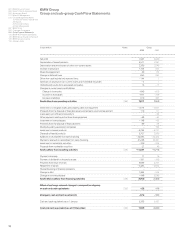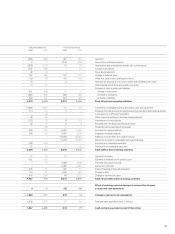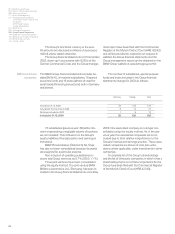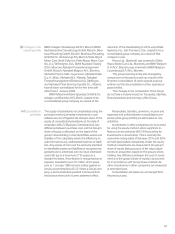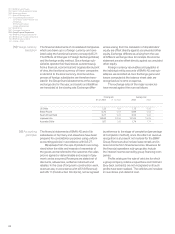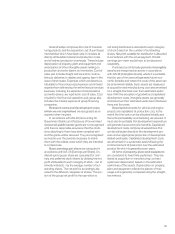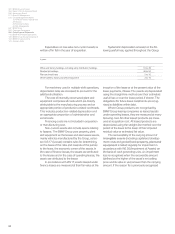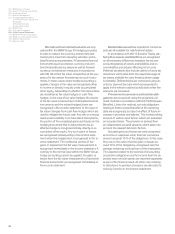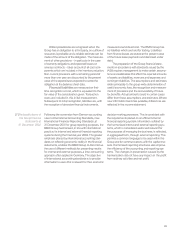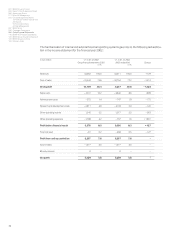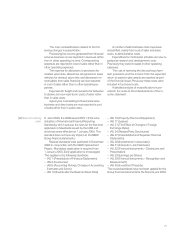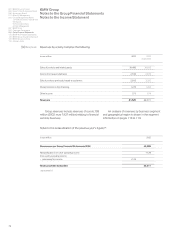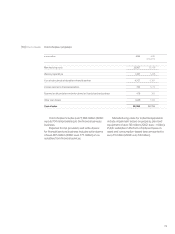BMW 2003 Annual Report Download - page 68
Download and view the complete annual report
Please find page 68 of the 2003 BMW annual report below. You can navigate through the pages in the report by either clicking on the pages listed below, or by using the keyword search tool below to find specific information within the annual report.67
impairment loss no longer exists, the impairment
loss is reversed up to the level of its rolled-forward
depreciated or amortised cost.
Financial assets are accounted for on the
basis of the settlement date. On initial recognition,
they are measured at acquisition cost, including
transaction costs.
Subsequent to initial recognition, available-
for-sale and held-for-trading financial assets are
measured at fair value. When market prices are not
available,
the fair value of available-for-sale financial
assets is measured using appropriate valuation tech-
niques e.g. discounted cash flow analysis based on
market information available at the balance sheet
date.
Loans and receivables which are not held by the
Group for trading (originated loans and receivables),
held-to-maturity financial investments and all finan-
cial assets for which published price quotations in an
active market are not available and whose fair value
cannot be determined reliably, are measured, to the
extent that they have a fixed term, at amortised cost,
using the effective interest rate method. When the
financial assets do not have a fixed term, they are
measured at acquisition cost.
In accordance with
IAS
39 (Financial Instruments:
Recognition and Measurement), assessments are
made regularly whether there is any objective evi-
dence that a financial asset or group of assets may
be impaired. If any such evidence exists, an impair-
ment loss is included in net profit or loss for the
period. Gains and losses on available-for-sale finan-
cial assets are recognised directly in equity until the
financial asset is disposed of or is determined to
be impaired, at which time the cumulative loss pre-
viously recognised in equity is included in net profit
or loss for the period.
Investments in non-consolidated group com-
panies reported in non-current financial assets
are measured at cost, since published price quota-
tions in an active market are not available and their
fair value cannot be reliably determined.
Associated companies are consolidated using
the equity method, whereby the investment is
measured at the Group’s share of the equity of the
company.
Investments in other companies are measured
at their quoted market price or fair value. When
these values are not available or cannot be reliably
determined, investments in other companies are
measured at cost.
Non-current marketable securities and loans
are measured according to the category of financial
asset to which they are classified. No held-for-trad-
ing financial assets are included under this heading.
Inventories of raw materials, supplies and
goods for resale are stated at the lower of average
acquisition cost and net realisable value.
Work in progress and finished goods are stated
at the lower of manufacturing cost and net realisable
value. Manufacturing cost comprises all costs which
are directly attributable to the manufacturing
process and an appropriate proportion of produc-
tion-related overheads. This includes production-
related depreciation and an appropriate proportion
of administrative and social costs.
Financing costs are not included in acquisition
or manufacturing cost.
With the exception of derivative financial instru-
ments, all receivables and other current assets
are items originated by the Group and are not held
for trading. They are measured at amortised cost.
Receivables with maturities of over one year which
bear no or lower than market interest rate are dis-
counted. Allowances are recognised to take account
of all identifiable risks.
Receivables from sales financing comprise re-
ceivables from customer, dealer and lease financing.



